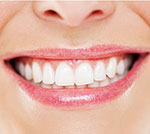 Why have Invisalign™?
Why have Invisalign™?
One of the main reasons that adults don’t like having braces is because they are so obvious, not many people are prepared to have traditional metal train track braces as an adult. This is where Invisalign offers you an alternative and is completely wireless.
Take a look at this photograph here, it’s difficult to believe that the woman in the foreground is actually wearing braces! But it’s true, Invisalign is almost completely imperceptible, clear and effective.
 What is Invisalign™?
What is Invisalign™?
Invisalign consists of a series of clear aligners. Each aligner puts a small amount of pressure on your teeth in the desired direction and moves them just a little bit towards their final destination.
Every two weeks you will replace your aligner with the new one which will continue this process.
The typical Invisalign treatment takes approximately 18 months to 2 years to complete.
How does it work so well?
Invisalign works so well due to a number of factors:
- The digital imaging that is done at the beginning of treatment.
- The planning stage, again all done digitally.
- The clear aligners which are comfortable and easy to wear and almost imperceptible.
- You can remove the aligner for convenience when eating and cleaning.
At the beginning of your Invisalign treatment you will undergo a Clincheck©.
Impressions of your teeth will be sent off to the Invisalign centre where they will be digitised. We will then receive back a video showing your teeth before and after treatment.
This video will actually show your teeth moving on the screen.
You will need to wear your Invisalign clear braces for at least 20 hours per day, removing them only to eat and clean your teeth. So long as you follow this process and stick to your treatment plan you will see amazing results within the time originally agreed.
What would life be like with straighter teeth?
Just take a few moments to imagine now how much better you might feel with  straighter teeth. An increase in confidence is often a primary reason for people to go ahead with orthodontic treatment, and that’s exactly what it provides. Added to this the advantages of being able to keep your teeth cleaner when they are straighter means that orthodontics is an extremely valid and important part of modern cosmetic dentistry and dental health.
straighter teeth. An increase in confidence is often a primary reason for people to go ahead with orthodontic treatment, and that’s exactly what it provides. Added to this the advantages of being able to keep your teeth cleaner when they are straighter means that orthodontics is an extremely valid and important part of modern cosmetic dentistry and dental health.
